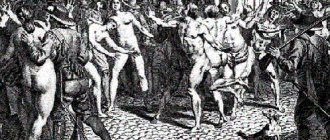10/31/1517. – Beginning of the Protestant Reformation in Europe
Reformation (lat. reformatio - correction, transformation, transformation, reformation) - a broad religious and socio-political movement in Western and Central Europe of the 16th - early 17th centuries, aimed at improving the health of the Catholic Church, but which led to the abandonment of the Church in general and its replacement by prayer gatherings of believers.
First of all, we should briefly characterize the state of Europe at that time. The main state structure in it was the “Holy Roman Empire” (from 1512 - “The Holy Roman Empire of the German Nation”), founded in 962 by the East Frankish king Otto I the Great and considered itself a continuation of the Roman Empire restored in the West by Charlemagne in 800 in rivalry with the Eastern Roman Empire. At its peak, the new empire included Germany, which was its core, northern and central Italy, the Low Countries, the Czech Republic, and some regions of France. The emperor was at the head of the empire, but his title was not hereditary, but was assigned based on the results of the election by a college of electors. The power of the emperors was rivaled by the papal throne. (“The Holy Roman Empire” existed until 1806 and was liquidated during the Napoleonic wars.)
The Reformation was directed against both ecclesiastical and political authorities in the empire. The center of the Reformation is considered to be Germany, which by the beginning of the 16th century was politically fragmented, as a result of which the Pope had great political and economic influence in individual feudal principalities, subjecting the population to exactions (tithes, indulgences, etc.). This and the moral corruption of the clergy served as the reason for the speech of Martin Luther, Doctor of Theology at the University of Wittenberg.
Martin Luther
On October 31, 1517, Luther nailed to the doors of the Wittenberg Castle Church his 95 theses against the abuses of the Catholic Church, in particular against the sale of indulgences, understood as the remission of sins for money, regardless of the sacrament of confession. The main theological position put forward by Luther stated that a person achieves the salvation of his soul not through the church and its rituals, but with the help of faith and grace given to him directly by God. Luther rejected all historical and dogmatic decrees of the church and papal decrees, assigning the role of the only source of religious truth to the Holy Scriptures in his own interpretation. (Thus, Protestantism gradually rejected almost all church liturgical traditions and sacraments (baptism, confirmation, confession, communion, consecration of oil, the sacrament of marriage and priesthood); most Protestant movements retained only the sacrament of baptism.)
Of course, the Pope issued a bull condemning Luther's teachings. On December 10, 1520, in front of a huge crowd of people, Luther burned this papal bull. The Holy Roman Emperor Charles V summoned Luther to the Imperial Diet in Worms in order to convince him to renounce his views. Luther, standing before the emperor, replied: “That’s where I stand. I can't do it any other way. May God help me." According to the Edict of Worms, Luther was outlawed throughout the empire, and repression began against his supporters.
The Reformation caused numerous religious conflicts, the largest of which was the Thirty Years' War from 1618 to 1648, which affected almost all European countries. Total losses, according to various estimates, ranged from 5 to 8 million people. Many regions of the empire, which had lost from 20 to 45% of its population, were devastated by famine, epidemics and remained deserted for a long time.
Historians consider the end of the Reformation to be the signing of the Peace of Westphalia in 1648, as a result of which the parties renounced their exclusive right to know the truth, and instead adopted the principle of religious pluralism and political decentralization. Recognition of national-state sovereignty for the princes meant that on its territory each state had full power and the prince had the right to choose his religion.
Protestantism has spread throughout Europe in the faiths of the followers of Luther (Lutheranism), John Calvin (Calvinism), the “Zwickau prophets” (Anabaptism), Ulrich Zwingli (Zwinglianism), and by now there are hundreds of Protestant denominations. (The most conservative branch of Protestantism at that time was Anglicanism, which arose in a special way.)
The Reformation provoked a response from the Catholic Church - the Counter-Reformation. As a result, Italy, Spain, southern Germany, part of the cantons of Switzerland, and Ireland remained Catholic. At the end of the 16th century, Catholicism won in the south of the Netherlands (the territory of modern Belgium) and in the Polish-Lithuanian Commonwealth. In France, Catholicism remained the state religion, but Protestants for a long time enjoyed the right of free religion.
The Counter-Reformation had both external and internal sides. If outwardly this was manifested in the violent suppression of the reform movement through the persecution of Protestants, the spread of the Inquisition and the creation of the Index of Forbidden Books, then internally these were some measures of purification in the Catholic Church itself.
In 1536, Pope Paul III created a commission that recognized that popes and cardinals were guilty of many abuses, putting mercantile interests above spiritual ones. In 1545, on the initiative of Paul III, the Council of Trent was convened, at which documents were adopted in connection with church abuses. Paul IV (a member of Paul III's commission) expelled 113 bishops from Rome who illegally left their dioceses. Even cardinals suspected of immorality were persecuted.
Nevertheless, the Catholics never overcame their main heretical innovations, and the leaders of the Reformation did not condemn them, limiting themselves to criticism of external abuses.
In addition to socio-economic reasons, the prerequisite for the Reformation was the freedom-loving ideas of the Renaissance with its exaltation of human individuality and earthly values, which were sought by the emerging bourgeois class, which wanted independence from church morality.
In this atmosphere, Jewry played a huge role in the Reformation. New York Rabbi L.I. Newman published a large study on this topic, summarizing: “almost all Christian reformers had at least one Jewish friend or teacher, and all the major movements of the Reformation had their origins in the world of the Hebrew Bible” (Newman, Louis Israel. Jewish Influence on Christian Reform Movements. New York, 1925). This led to the formation of Freemasonry as a union of Protestantism with Judaism (with the goal of undermining Christian monarchies and gaining equal rights for Jews) and the emergence of Judaized Christian sects, of which the most famous are Puritanism in England and Calvinism in Switzerland, which accepted the Jewish interpretation of wealth as divinely predetermined chosenness. These sects and Protestantism in general became most widespread in America, including with the ideology of the so-called. “Christian Zionism”, interpreting Russia as an “evil empire”, “Gog and Magog”, which will find its destruction in the war against “Israel”.
However, both in the USA and in Europe there are also Protestant authors who criticize Judaism for Nazism and the preparation of the kingdom of the Antichrist, as well as anti-Christian globalization. For example: a famous book by the American evangelical historian and theologian: Theodore Winston Pike. “Israel: Our duty... Our dilemma (1984); published by the German publishing house Bibel- und Schriftenmission Dr. Kurt E. Koch eV books by anti-globalist pastor: Wolfgang Borowsky. "Christus und die Welt des Antichristen" (1984); "Kommt Lyzifer an die Macht?" (1985).
In general, the Reformation of Western Christianity weakened moral prohibitions in socio-economic activity, which became the reason for the emergence of capitalism. This was convincingly explored by the founder of sociological science M. Weber in his famous work “The Protestant Ethic and the Spirit of Capitalism” (1904).
In secular encyclopedias, Jan Hus (1369‒1415), a national hero of the Czech people, who lived a century earlier, is usually classified as Protestant. He was a priest and for some time the rector of the University of Prague, protested against the vices of the Catholic clergy. Hus steadfastly adhered to his convictions and was burned in Constance along with his works. The execution of Hus sparked the Hussite Wars (1419‒1434). The reasons for Hus's criticism of Catholicism were in many ways the same as those of Luther, but here is what the prominent pre-revolutionary theologian Prof. wrote about this Czech martyr and his associates. A.P. Lopukhin.
“In the depths of his soul, the Cyril and Methodius legends have not yet faded away, the internal historical thread that connected him with the Orthodox East has not yet broken. And so, in the person of his best people, these traditions were revived again, their gaze turned again to the Orthodox East, where the church lived without the pope and their corrupting policies - lived in simple piety, according to the tradition of the apostles and oh. churches. If somewhere, then it is there, in the Orthodox Church. East, we need to seek salvation from the evils and adversities depressing the Western Church. Unfortunately, entire centuries of alienation from the Orthodox Church. East from the general movement of the Western world and especially its sad situation under the heavy yoke of Islam did not give the opportunity to realize this desire of the soul of the Czech people to restore the old Cyril and Methodius traditions and, as their necessary consequence, reunification with the Orthodox Church. East, and the whole movement acquired a different character, finding stimulus and encouragement in the movement that arose on the outskirts of the Western world - in England and had a similar character in the sense of protest also against the papacy and its affairs. The culprit of this movement was Viklef, whose transformative ideas, which did not have much success in England itself, however, found warm sympathy and widespread dissemination in various European countries and especially in the Czech Republic...
The main source of Christ. he [Jan Hus] considered the Holy Scripture to be his doctrine and life, without denying, however, another source, namely the Holy Tradition. Against the accusation that he expounds Holy Scripture according to his own reason and does not comply with the interpretations of the fathers of the church, he cited in his defense what in fact he often cites the opinions of the fathers and teachers of the church. – He outlined his beliefs and views regarding the church mainly in the “Treatise on the Church”, read in the Bethlehem chapel... As for the papacy, Hus directly says that not the pope, but only Christ is the head of the universal church (caput, capitaneus). There cannot be two chapters, otherwise a monster would emerge... Only in that case is the bishop of Rome the vicar of Christ, the heir of Peter, the holder of the apostolic see, when he follows in the footsteps of Christ, teaches and lives in an apostolic manner. Papal commands must be followed only when they are based on the law of Christ, otherwise they must be opposed...; sometimes it can become a duty to preach the Gospel in spite of papal excommunication, as Hus did... Both in the doctrine of justification and in relation to the calling of saints, he stood on the basis of the ancient church. This is his significant difference from Viklef, who openly left this ground and, undoubtedly, was guilty of various heresies and errors, and if Hus was carried away by the writings of Viklef, it was not because he sympathized with his teaching in its entirety, but simply because he found in him a source of inspiration and excitement for his aspirations for freedom of the national-religious spirit from the heavy and shameful yoke of papal tyranny” (Orthodox Theological Encyclopedia).
1415 Burning of Jan Hus. Colorized engraving from the publication “Chronicles of the Council of Constance”
+ + +
There was no Reformation in the Russian Church. The Orthodox understanding of the Reformation in Russia began soon after Luther’s speech. It is mentioned by Maxim the Greek, who, while rejecting Luther’s reform program, agreed with him in his assessment of the papacy. By the 1640s refers to the satirical poetic “Exposition on the Luthors” by the Moscow scribe Ivan Nasedka, who relied on the experience of the polemical writings of Archimandrite Zacharias Kopystensky.
However, due to close contacts with European states, as well as military clashes, Protestants began to appear in Russia - masters, as well as prisoners of war, who were allowed to practice their faith by the Russian Tsars. In Moscow and a number of trading cities there were “German settlements” where Protestants lived and there were Protestant churches. Russian authorities usually did not interfere in their internal life.
Only in the era of Peter the Great the spirit of Protestantism, together with everything Western, became welcomed in Russia. The activities of Peter I to transform the Russian Church (abolition of the patriarchate with the subordination of the church to secular power, restrictions on monasticism) are associated with Protestant influence. At the same time, Freemasonry also penetrated into Russian high society. The result is known.
At the end of the 19th century there were about 5 million Protestants in the Russian Empire. These were mainly residents of Finland and the Baltic states, as well as immigrants, including Russified ones (for example, Russian patriots V.I. Dal and Count General F.A. Keller were Protestants for most of their lives, and converted to Orthodoxy at the end of their lives). Protestants had no restrictions on service along with Catholics and Orthodox Christians. By 1917, there were only about 200 thousand native Russian Protestants in Russia.
In the mid-1990s, the number of Russian Protestants was just over 1 million believers. In the mid-2000s. 2 million people were considered parishioners of Protestant churches. According to the Pew Research Center, in 2010 there were 2.56 million Protestants in Russia. In 2014, based on field research and data from Protestant unions, religious scholar Roman Lunkin announced that there were 3 million Protestants in the Russian Federation.
Along with the growth in the number of Protestant communities, their share among religious associations registered by the Ministry of Justice of the Russian Federation is also growing. If in 1991 Protestants made up 3% of all officially registered religious associations, then by 2008 this number reached 21%. In 2012, the Ministry of Justice database contained information about 4.4 thousand Protestant religious associations. However, a significant number of Protestant communities operate without registration. According to the Protestants themselves, by 2014 there were about 10 thousand Protestant communities in Russia. In any case, growth is obvious.
More than 90% of modern Russian Protestants became such after 1990 thanks to foreign missionaries.
Over half of Russian Protestants are Pentecostals and Charismatics. Other major Protestant denominations include Lutherans, Adventists, and Evangelical Christian Baptists. The country also has communities of Evangelical Christians (Prokhanovites), Methodists, Presbyterians, Reformed (Calvinists), Mennonites, Anglicans, the Salvation Army, Perfectionists, Restorationists, Quakers, and others.
M. N. Information from Wikipedia was used.
Explanation. In the 16th century, Europe had the Julian calendar, but there was no Gregorian calendar yet. And according to the Julian calendar, October 31 this year corresponds to November 11, but in Europe they keep the date October 31 BC. Art. This holiday is a national holiday in the German states as Reformation Day. Since this holiday is Western, we also put it on the calendar on this date.
Permanent page address:
Leave your comment
« Previous entry
Causes of the Reformation
Catholicism was a whole system that imposed a framework on the entire culture and social organization of European peoples:
- — Catholic universalism denied nationality — The theocratic idea oppressed the state — The clergy had a privileged position in society, subordinating the secular classes to church tutelage — Dogmatism provided thought with too narrow a sphere — The Catholic Church degenerated from a consoler and conductor of ideas of social justice into a cruel feudal landowner and oppressor — Inconsistency the lifestyle of church ministers to what they preached - Incapacity, licentiousness and corruption of the church bureaucracy - Growing material demands of the Roman church: all believers paid tithes - a tax of 1/10 of all income. There was an open trade in church offices - The existence of a huge number of monasteries, which had extensive land holdings and other wealth, with a large idle population - The sale of indulgences, begun to finance the construction of St. Peter's Basilica in Rome, too clearly and cynically demonstrated not the Church's concern for the souls of the flock, but desire for enrichment, earthly goods - Invention of printing - Discovery of America - Renewed interest in ancient culture, accompanied by the flowering of art, which for many centuries served exclusively the interests of the Church
- All secular institutions of European society united in the struggle against the Catholic Church: state power, the emerging bourgeoisie, the oppressed peasantry, intellectuals, and representatives of the liberal professions. They fought not in the name of the purity of Christian doctrine, not in the name of restoring the Bible as the main authority in matters of religion, not in the name of the demands of conscience and religious thought, but because Catholicism interfered with the free development of social relations in all spheres of life
The Bible, not the church. Christ, not the Pope
John Wycliffe, a professor at Oxford University, came up with such a motto, which rethinks religious values, at the end of the 14th century, long before the Reformation. He became the man who reminded Catholics of the old ideas on which Christianity grew. For which he was considered a heretic.
One of the forerunners of Protestantism, John Wycliffe was the first to translate the Bible into English, but the Roman Church did not appreciate his efforts, since it was endowed with an absolute monopoly on the interpretation of the Bible. Wilcliff taught that every person is connected with God directly, and for this he does not need any intermediaries. For these acts, as well as for branding the Pope an apostate and Antichrist, he was dismissed from Oxford, and his students were forced to renounce his views.
Vladislav Muttikh. "Jan Hus at the stake in Constance." (Pinterest)
However, this could no longer prevent the spread of his ideas: the teachings of the Wyclifists became the ideological basis for the Lollard community and for the sermons of Jan Hus. The latter was burned at the stake along with his works for his ideas. Wycliffe's corpse was dug up by decision of the Council of Constance and also burned at the stake. Exemplary executions for a long time discouraged thinkers from wanting to reform the church.
Reformation in Europe
The formal beginning of the Reformation is considered to be October 31, 1517, when the vicar of the deanery of the Augustinian Order, Martin Luther, published his 95 theses against the trade in papal indulgences*
- 1520s - Germany
- 1525 - Prussia, Livonia
- 1530s - England
- 1536 - Denmark
- 1536 - Norway
- 1540 - Iceland
- 1527-1544 - Sweden
- 1518-1520s - Switzerland: Zurich, Bern, Basel, Geneva
- 1520-1530s - France: Lutheranism and Anabaptism
- 1550s - France: Calvinism
- 1540-1560s - Netherlands
The emergence of Protestantism
After the end of the peasant war, some of the German princes continued the secularization of church lands. Some spiritual princes renounced their rank and declared themselves sovereigns of their former spiritual principalities. This is what, for example, the Grand Master of the Teutonic Order did, who in 1525 took the title of Duke of Prussia. Another part of the princes, frightened by the peasant war and seeing its causes in the Reformation, remained faithful to Catholicism.
Emperor Charles V, defending the interests of the Catholic Church, convened the Reichstag in 1529, at which he demanded that the princes stop the secularization of church lands. The princes, supporters of the teachings of Martin Luther, protested. This is how the word Protestantism appeared, denoting one of the trends in Christianity. The main tenets of Lutheranism were set out in a document called "Apology of the Augsburg Confession."
Figures of the Reformation
- Martin Luther (1483–1546) - Germany
- Philip Melanchthon (1497–1560) - Germany
- Hans Tausen (1494–1561) - Denmark
- Olaus Petri (1493–1552) - Sweden
- Ulrich Zwingli (1484–1531) – Switzerland
- John Calvin (1509–1564) - France, Switzerland
- Thomas Cranmer (1489–1556) - England
- John Knox (1514?–1572) - Scotland
- J. Lefebvre (1450-1536) - France
- G. Brisonnet (1470-1534) - France
- M. Agricola (1510-1557) - Finland
- T. Munzer (1490-1525) - Germany
- As a result of the Reformation, some believers adopted the ideas of its main figures Luther and Calvin, turning from Catholics to Lutherans and Calvinists
Brief biography of Martin Luther
- The main idea of Lutheranism is salvation by personal faith, which is given by God, without the help of the church. The connection between God and man is personal; the church is not a mediator between God and man. All believers are recognized as equal before Christ, priests lose their position as a special class. Religious communities themselves invite pastors and elect governing bodies. The source of doctrine is the Bible, which the believer has the right to independently explain. Instead of Latin, services are conducted in the native language of the believer
How is the anniversary celebrated?
The Evangelical Church in Germany declared an entire anniversary decade, the “Luther Decade.” It began in 2008. Each year the focus is on one specific topic, for example, “Image and the Bible” (2015), “Reformation and Politics” (2014), “Reformation and Music” (2012). On October 31, 2021, celebrations of the Reformation will take place throughout Germany. Various events and exhibitions are held to mark the anniversary. Separately, three nationwide national exhibitions should be mentioned, united by the common sign “The Reformation in Full Force” and highlighting various aspects of this historical event. The exhibition in Berlin is dedicated to the global resonance of the Reformation (“The Luther Effect”), in Wittenberg to the influence of the young Luther on people (“Luther! 95 values – 95 people”), in Eisenach to the changing understanding of the Germans about the Reformer (“Luther and the Germans”).
©
Brief biography of John Calvin
- 1509, July 10 - born in the French city of Noyon
- 1513-1531 in Paris, Orleans, Bourget studied the humanities, law, theology, received a licentiate degree
- 1532, spring - published his first scientific work at his own expense - comments on Seneca’s treatise “On Meekness”
- 1532 - received his doctorate in Orleans
- 1532, second half - became a Protestant
- 1533, October - wrote a speech “On Christian Philosophy” for the rector of the university Nicolas Copa, for which he was persecuted
- 1533-1535 - how the author of a seditious speech hid in the south of France
- 1535, winter - fearing for his life, fled to Switzerland
- 1536, first half - lived in Basel and the Italian town of Ferrara at the court of the Duchess of Ferrara Rene, daughter of King Louis XII, published his main work “Establishments of the Christian Faith”
- 1536, July-1538, spring - lived in Geneva until he was expelled
- 1538-1540 - Bern, Zurich, Strasbourg
- 1540, September - marriage to the widow Idelette Shtorder
- 1541, September 13 - return to Geneva by decision of the City Council
- 1541, November 20 - presented a draft charter of the church, which was approved by the General Assembly of Citizens
- The charter provided for the election of 12 elders. Judicial and supervisory power was concentrated in the hands of the elders. The entire government structure of Geneva acquired a strict religious character. Gradually, all city power was concentrated in a small council, over which Calvin had unlimited influence. The laws adopted at the insistence of Calvin were intended to make Geneva a prototype of the “city of God.” Geneva was to become Protestant Rome. Calvin called for strict monitoring of cleanliness and order in Geneva - it was to become a model for other cities in everything. Calvin considered the task of the church to be the religious education of all citizens. To achieve this, Calvin carried out a series of reforms aimed at establishing “worldly asceticism.” The pompous Catholic cult was abolished, and strict administrative measures were taken aimed at strengthening morality. Petty and captious supervision was established over all citizens. Attendance at church services became mandatory; entertainment, dancing, bright clothes, and loud laughter were prohibited. Gradually, not a single theater remained in Geneva, mirrors were broken as unnecessary, elegant hairstyles were obstructed. Calvin had a heavy, domineering character. He was intolerant of both Catholics and representatives of other reform movements. At his insistence, opponents of his teaching were subjected to expulsion and even death penalty. In 1546 alone, 58 death sentences and 76 decrees of expulsion from the city were passed in Geneva.
- 1553 - by verdict of the Geneva consistory, M. Servet was executed for heretical views. For the first time, the Protestant Church passed a death sentence for dissent.
- 1559 - Founding of the Geneva Academy - a higher theological institution for the training of preachers
- 1564, May 27 - Calvin died. He was buried without ceremony, without a gravestone. Soon his burial place was lost
- The main idea of Calvinism is the doctrine of “absolute predestination,” according to which God, even before the “creation of the world,” predestined some people to “salvation” and others to “destruction,” and this sentence of God is absolutely unchangeable. However, the doctrine of “absolute predestination” was not fatalistic in nature. According to Calvinism, life is given to a person in order to reveal the abilities inherent in him by God, and success in earthly affairs represents a sign of salvation. Calvinism proclaimed new moral values - frugality and prudence combined with tireless work, moderation in everyday life, the spirit of entrepreneurship
Confrontation between Protestant princes and Catholic princes
The confrontation between the Protestant princes and the Catholic princes, who were supported by the emperor, resulted in two wars . These are the so-called Schmalkalden Wars. But the fighting did not lead to an advantage on either side, and in 1555 a religious peace was concluded in Augsburg. The emperor recognized the right of princes to independently decide what religion would be in their state. Thus, the principle triumphed: whose land is his faith. Subjects had to profess the religion to which their prince belonged.
The northern and northeastern lands of Germany, as well as some central principalities, adopted Lutheranism. The South remained Catholic. The religious peace of Augsburg cemented Germany's political fragmentation. Gradually, in the 16th century, Lutheranism spread throughout Europe. It became the official religion in Denmark, Norway, Finland and the Baltic states.
Counter-Reformation
Every action implies a reaction. Catholic Europe responded to the Reformation movement with the Counter-Reformation (1543 - 1648). The Catholic Church refused to provide indulgences, new monastic orders and theological seminaries were founded, a uniform liturgy (the most important Christian service), the Gregorian calendar were introduced, the Reformation was suppressed in Poland, the lands of the Habsburgs, and France. The Counter-Reformation formalized the final break between Catholicism and Protestantism







